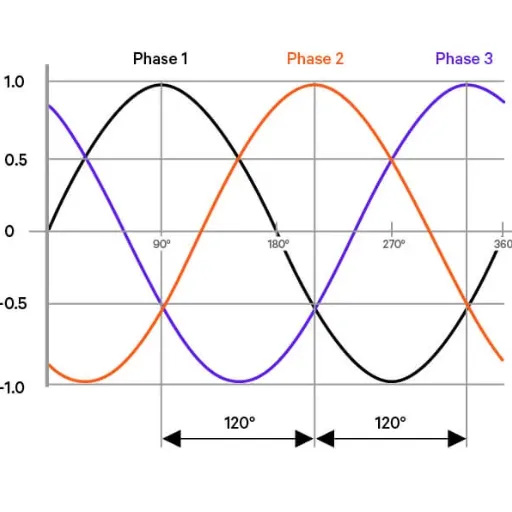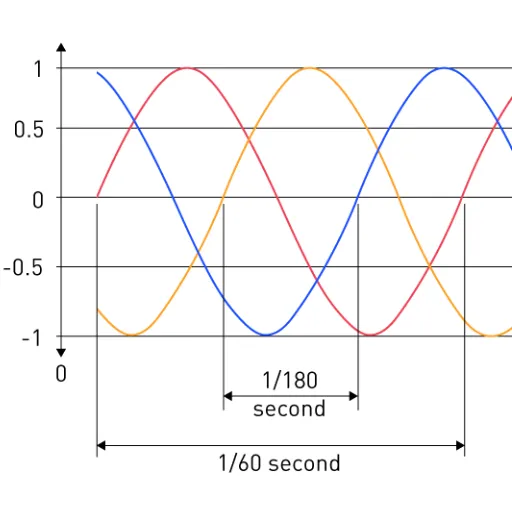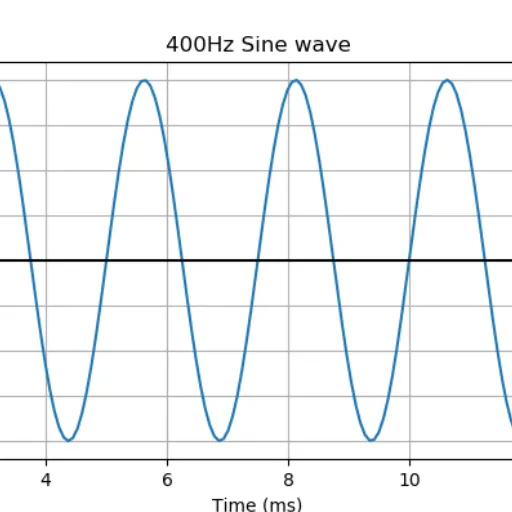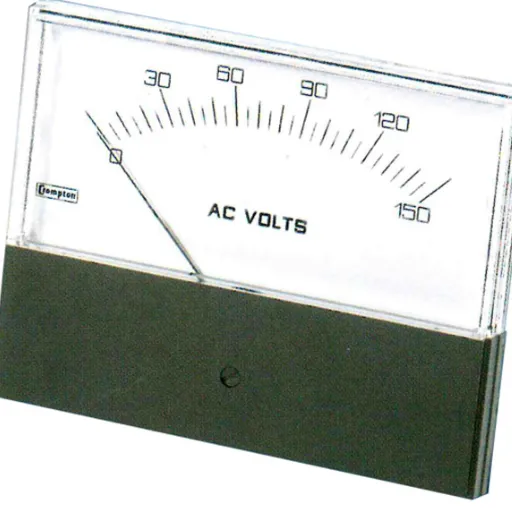Alternating current (AC) is a vital component in powering our homes, factories, communication devices, and other appliances. One key consideration about AC electricity is the frequency, which often goes unnoticed. And that is why we have set out today’s supply to be 50Hz and 60Hz in some countries. So, what does it mean and how does it help us? You may be a sole proprietor, attempting to understand the electric force, and wondering. In this publication, however, all of the preceding are covered. From the internal workings of AC power frequency to how it damages apparatuses and even impacts the globe’s energy, we are exploring everything. You will be on your way to completing the post by understanding the basics of alternating current frequency and its importance in today’s world. Off we go!
Introduction to AC Power Frequency

AC power frequency is the rate at which the Alternating Current (AC) flows after the stator has been turned, and it is measured in hertz (Hz). Some of the largest countries, for instance, are using systems having a base frequency of either 50Hz or 60Hz, depending on regional specifications. This is because this particular characteristic of the ambient regime might be regarded as one of the most important for the successful exploitation of electrical application devices, as many such developments take place on the setup of the semblance electrical moderates any electrical activities on one another to create a single infrastructure. But some of these developments are fixed in static components, so the choice of the frequency can not be changed. Moreover, supply transportation and power transformation, which includes the installation of additional equipment such as inverters for the power system, is necessary for such developments to make appropriate changes.
What is AC Power?
Alternating Current, often abbreviated as AC, refers to the electrical current where the direction of the current regularly reverses. Unlike direct current, abbreviated as DC, this is the type of current where the electric flow is unidirectional. The time it takes for the voltage to rise and fall in AC power is called the frequency, which is measured in Hertz (Hz) as the number of cycles per second. The benefits of AC power are profound when it comes to the transportation of electricity over long distances, as it is easier to adapt and supportive with the use of transformers, which can regulate voltage at transmission levels to curb the losses that occur during distribution. Practically all of the appliances, either in households or in industry, work by AC power, but a substantial proportion of it is often in manufacturing activities in the modern backboned economy or even high-tech industries and services.
Importance of Frequency in AC Systems
The frequencies of the AC Power System are of great importance in determining the functionality of a system. For any given system, it is the frequency that helps achieve most of its tasks, such as in standard equipment operation at certain fixed standard frequencies, viz, 50 Hz and 60 Hz. Deviations from standard frequencies have the effect of disturbing sensitive appliances and energy wastage, up to the destruction of equipment in worst cases. Frequency control becomes significant in power systems, where even small changes can significantly affect frequency or even lead to instability, particularly in conjunction with outages or a lack of synchronization between two or more systems. With the availability of modern technology on real-time grid monitoring systems and advanced use of smart inverters, the challenges mentioned can be easily managed, thereby ensuring reliability and sustainability. In order to maintain the frequency, there is a huge need to take place whenever heavy equipment is used or water bodies are positioned to generate electricity. We all know this is time-consuming, but it is so important, especially for industrial setups, commercial, as well as domestic use.
Overview of Utility Frequency
The frequency of a power utility is, in fact, a measure of the rate at which an alternating current (AC) changes its direction. In practice, two frequencies, namely 50 Hz and 60 Hz, are used throughout the world. In this regard, while Europe, Asia, and Africa prefer the former, countries in the North and some in South America use the latter. This practice also ensures that the electrical appliances and systems used are the same in these regions. Frequency deviations from the nominal value lead to consequences such as equipment failure or an increase in fuel resources and machinery maintenance. Modern grids are expected to deliver today’s most cutting-edge technologies, which include: real-time monitoring of influences; automatic frequency control/ station control, and all other technologies known in the art that are capable of damping oscillations to tolerable levels in the system under consideration. Also, the growth of renewable sources of energy has introduced its own challenges to frequency management as renewable sources are by their nature off and on demand;- this state of affairs creates the need for sophisticated storage technologies and ancillary support services for the energy balance.
Standard Frequencies: 50 Hz and 60 Hz

For each particular region, there is a standard energy frequency, which is not the same across the globe, but it is agreed that it would be either 50 or 60 hertz. The choice of frequency will be driven by the regional infrastructural history, essentially. For instance, Asia, Europe, and Africa are likely to use 50 hertz. In contrast, chiefly North America and some countries in South America, relative to the rest of the nation(s), use 60 hertz. 50 hertz and 60 hertz systems are designed to perform the same functional duty, which allows for the distribution and consumption of electrical energy, but how the systems are designed is where the differences occur. These standards remain a crucial aspect of ensuring that there are no conflicts in the use of electrical power across different parts of the world.
Global Usage of 50 Hz and 60 Hz Frequencies
Throughout the world, the ratio of 50 Hz and 60 Hz was established in many parts of the transmission system due to historical forces and the needs of modern technology. Predominantly, for example, 50 HZ is found in regions of Europe, Africa, and much of Asia, about half of all the world’s countries like Germany, India, and South Africa standardize here; Whereas, the United States, Canada, and certain areas of North and South America countries, predominently employing a 60 Hz electricity frequency for their systems use other measures. The difference between these frequencies is the distance they can cover in a radial distance (power generation and transmission systems). Much of the early work of Tesla and Edison in America had a lot to do with this. Regional norms more often than not proclaim 50 Hz as the reference more than others, while 60 Hz is used for others; it becomes the primary frequency in existence. Attitudes and adjustments towards manual or device scope wrtíe to for relations in these regions continue. Global industries and international travel, especially, often require electricity converters or, more commonly, dual-frequency appliances to resolve the arising conflicts.
Differences Between 50 Hz and 60 Hz AC Systems
| Parameter | 50 Hz System | 60 Hz System |
|---|---|---|
| Frequency | 50 cycles per second | 60 cycles per second |
| Regions Used | Europe, Asia, Africa | Americas, parts of Asia |
| Voltage Standards | Typically 220-240V | Typically 100-120V |
| Efficiency | Slightly less efficient for motors | Slightly more efficient for motors |
| Transmission Line Loss | Lower losses due to slower frequency | Higher losses due to faster frequency |
| Generator Size | Larger generators often required | Smaller generators suffice |
| Flicker in Lighting | May cause noticeable flicker | Flicker is generally less noticeable |
| Transformer Design | Larger transformers needed | Smaller transformers often suitable |
| Motor Speed | Motors run slower | Motors run faster |
| Appliance Compatibility | Region-specific appliances required | Region-specific appliances required |
Implications of Using Different Frequencies
The availability of 50 Hz or 60 Hz frequencies plays a major role in the design of effective power systems. For a lot of manufacturing needs, the larger 60 Hz frequency allows well-constructed power systems, which are more expensive and probably smaller, saving space, which is why most energy-intensive regions are within that frequency. However, 50 Hz predominance prevailed in most economies due to developmental reasons, thus making the equipment more competitive internationally.
There are likely benefits in terms of reduced losses at certain locations and with specific loads when using a 60 Hz system, from the perspective of energy conservation. But there may be some drawbacks for a 50 Hz system, such as the need for larger machines and devices like generators and transformers, which may increase the cost of the grid and connections, domestic or industrial. This awareness is beneficial for creating devices that can be applied in different countries and for different frequency systems. There is a tendency in new technologies towards work in the mode of “one size fits all” with respect to frequencies.” This implies that a given piece of equipment, product, or system has software, hardware, and other components, such that it can be easily switched over to work in a different frequency setting.
Understanding Hertz and Its Role in AC Power

Hertz, in short Hz, refers to the frequency unit that denotes the number of wave cycles per second noticed in an alternating current(AC) line. It is most important since it has the power to either make or break the compatibility of electrical appliances with the source of power. Various localities offer either 50Hz or 60Hz supply, which governs the design layout of power grids as well as structures. The essence of Hertz lies in ensuring that equipment receives power that is cycle matched, or rather, operational cycles do not lead to hitches or waste. Manufacturers and users can therefore anticipate the issues arising from operating the system with the necessary current frequency before the installation process.
Definition of Hertz (Hz)
The hertz (Hz) is a unit of measurement in the International System of Units (SI), and is defined as equivalent to one cycle per second. It quantifies the amount of cyclical vibrations or oscillations, for that matter, that a wave does in the course of 1 second. Accompanied by alternating current (AC) electricity, audio signals, and electromagnetic waves, the so-called ‘hertz’ is a core principle in electronics and physics. For instance, most electrical systems are of a specific frequency—either 50 Hz or 60 Hz, particularly depending on the region, to ensure effective performance of the devices. Likewise, audio frequencies typically range from 20 Hz to 20,000 Hz, excluding the range of sound that is perceived by the human ear. It is also with the aid of this unit that new technology is rolled out with ultimate accuracy, information is transmitted more effectively, and the various systems of modern electricity operate appropriately.
How Hertz Affects Voltage and Power Supplies
A power supply’s waveform influences performance, which in turn affects the voltage characteristic. Machines that are power-driven alternating current (AC) systems typically operate at fixed system frequencies of 50 or 60 Hz, and this influences the design of transformers, some motors, and other electrical devices. For example, a piece of equipment specified at 60 Hz could overheat or experience a drop in efficiency when connected to a 50 Hz power supply, as these systems are not identical, but similar; thus, operational specifications differ. It is also true that Transformer Size depends on the design frequency, as most times a higher frequency results in smaller and lighter transformer parts.
Changes in frequency can also cause deviations in voltage, potentially leading to a breach of voltage stability and damage to electrical utility equipment. This is especially crucial in industries where certain processes or equipment, such as data centers and medical facilities, require constant ideal power. Frequencies in current power grids are constantly monitored, and this policing is coupled with frequency regulation technologies for correction in the voltage output so as to achieve its ideal value. This is an example of advanced power management techniques that demonstrate the nexus of hertz and voltage within worldwide power networks.
50 Hz and 60 Hz in Practical Applications
The selection of either the 50 Hz or 60 Hz frequency standard has far-reaching implications across numerous technologies and fields worldwide. It is highly unlikely that the implementation of either of these two standards will exclude any other world region from its use, since each one has cost implications in its development. It is common to encounter 50 Hz systems in regions such as Europe, Asia, and Africa, unlike in many cases where people have to deal with 60 Hz supplies in countries like the United States, Canada, and parts of South America. The standard frequency difference is taken into account in the manufacturing and operation of electrical equipment, such as generators, transformers, and household appliances, which are often adapted to the pedigree.
As an illustration, in facilities, say a medium-sized metal fabrication factory or scheduled industries, certain motors and pumps will have to be set in such a way that they work at the frequencies of the option in order to realize the pump and motor efficiencies. It may happen that the excruciating speed or power of the 60Hz manufactured motor or pump may be forced to function within the boundaries of the 50Hz only, and this could be the beginning of reduced performance, followed by temperature rise in the machine. Moreover, power plants take the frequency of operation into account while designing the turbines and the associated equipment, as the other frequencies will allow more compact constructions in some cases.
Furthermore, the relevance of standards in international trade increases with the increasing applicability of electronics throughout all interconnected systems. To practice international marketing, the companies design products, which can be used at very different frequencies. For instance, consumer electronics like laptops and phone chargers are often designed to operate at a frequency that is in great demand in the U.S., where the standard is 60 Hz, and in Europe, where it is 50 Hz.
Special Frequencies: 400 Hz and Beyond

Frequency specifications around 400 Hz or higher are often associated with employment in specific industries, such as air transport, aerospace, or defense applications, and are widely adopted in these fields. The 400 Hz standard is accepted in these business segments because relatively lightweight types of equipment can be designed. The importance of low weight in the design of aircraft and spacecraft cannot be underestimated. For instance, within many aircraft, the optimal operating frequency of 400 Hz is preferred in order to minimize the volume and weight of the transformers in the system without compromising the overall performance. Additionally, frequencies above 400 Hz are utilized in applications that require advanced technologies, such as electric traction in high-speed trains or certain types of medical equipment. In such cases, frequencies above 400 Hz are necessary to achieve high precision, and in many cases, permit the adoption of creative system designs sensitive to particular requirements. In such cases, the maximum number of such frequencies is low since most other potential fields are shunned and implementing them is too high.
Applications of 400 Hz in Aviation and Military
Aircraft Power Systems
400 Hz is essential for all systems of the aircraft to function and for the weight and volume of electric elements to decrease. All devices, whether they be transformers or other devices, including generators, engines, and osculating equipment, absorb less space when working at these frequencies rather than at lower speeds such as 50 Hz or 60 Hz. This reduction in mass is crucial for enhancing the fuel economy and improving the payload capability. This decrease in payload weight results in an underweight rating. Current civil and military aircraft, including dedicated war battle machines such as the F-35, and giant transportation vessels like the C-130 Hercules, have 400 Hz power sources for navigation, lightning protection, or other purposes.
Ground Support Equipment (GSE)
400 Hz power can be used in another area, specifically airports and bases for aircraft operations. Therefore, within this serving territory, special Ground Power Units (GPUs) have been deployed, whose task is to provide all necessary power to the parked airplanes. Such a connection also enables one to use the auxiliary systems without firing up the propulsion plant of the aeroplane, powering the driving. According to investigations, the introduction of 400 Hz ground power supply systems resulted in a 20% increase in operational efficiency compared to traditional devices.
Missile Systems and Radars
Several guidance software programs for torpedoes and ballistic missiles, as well as radars used in warfare situations, require the use of 400 Hz power supplies. The use of high-frequency power enables fast signal/data processing and minimizes errors in navigation and combat areas. Take, for example, the AN/APG series of radar fitted on fighter jets, which used 400 Hz to obtain a clear, improved image quality and resolution in the tracking devices.
Naval Applications
Certain marine vessels, particularly those with fast or next-generation submarine designs, also feature a 400 Hz power supply to support specific activities. These frequency systems support control applications through the power source, which reduces the need for panel wiring in power distribution and enables the development of more efficient systems for operations in restricted areas.
Electronic Warfare Systems
There are instances where advanced types of arsenal are utilized, including jamming and countermeasures, which work on 400 Hz power. For the reliability of these components in an unstable high-level application is usually compromised, therefore, the use of high-frequency energy is applied to maintain dynamics at all times.
Advantages of Higher Frequencies
Reduced Size and Weight
When it comes to dealing with higher frequencies, as in the case of 400 Hertz, the minimization of transformers, alternators, and electric motors is significantly more possible. To justify this, a 400 Hz transformer can be as much as 25-30% lighter compared to an equal 50 Hz transformer. This is a key gain for aerospace systems, where little construction weight is a criterion that has to be met.
Improved Efficiency in Power Transmission
However, utilizing higher frequencies can help reduce energy loss during transportation, thereby increasing the efficiency of power transfer. For example, in the power supply systems of an aircraft, the extensive use of 400 Hz allows the designer to downsize the cabling wire size while still transferring power within the aircraft system with minimal losses – a great step towards a more energy-efficient society.
Enhanced Dynamic Response
By this principle, systems that operate at higher frequencies will have better response times. For tactical environments, such as electronic warfare or servo motor applications, a delay of even one millisecond is unacceptable.
Optimized Space Utilization
Devices operating at high frequencies or their elements, such as windings of electric motors, transformers, or energy-consuming devices, are usually compact and occupy less space, which makes it possible to deploy a complex of such devices. This is essential in confined spaces such as submarines, airplanes, or wheeled vehicles.
Higher Power Density
Working with high-frequency devices in turn advances the power density achievable. Power density refers to the amount of power generated in a given volume, meaning that such systems can be used in applications where there is not much space, the power being put to be greater.
Reduced Energy Storage Requirements
Higher frequencies mean less capacitance, and inductance can be used in the system. For example, a battery converter operating at 400 Hz would require tweaker capacitance and inductance values compared to those of a battery converter operating at 50 Hz, as the latter would require those in the range of up to 20% of its size. And discussed issues, also provided device scale down and cost cutting.
Historical Context and Evolution of AC Frequency Standards

Standards, on the other hand, which regulate the frequency of an alternating current, have been agreed upon across many industries such as processing, residential, and commercial sectors. Initially, the harmonization of the frequency of various utility frequency devices was not realized, hence values of frequencies from 16 Hz upto 133 Hz were implemented in different parts of the globe owing to the lack of a frequency standard for that time. Thereafter, due to the need for frequency, it was preferable to improve interoperability and efficiency; therefore, some outgoing fakes and specifications had to be resolved, primarily with European and American countries on interconnections.
The two most prevalent frequencies that received this endorsement were 50Hz, used in Europe, Asia, and Africa, and 60Hz, used in the Americas. These selections were made possible by practical considerations in electricity generation and also stem from the early 20th-century design practices of the Meas. For instance, it is recorded that lower frequencies, such as 25 Hz, were in use for sleeved motors and industrial drives. Still, they were phased out because of the problems associated with them, leading to the abandonment of these, with the earlier limitations concerning lighting slowly being resolved by advances in electronic and electrical technology.
The development in the applicability choice of the frequency standard, with societies shifting the particular frequencies adopted according to infrastructure and economic growth, has promoted the design of devices and even reduced the costs of other peripherals in favorable economic environments. To underscore this point, the need for AC frequency standards is complicated by such complexity that is directionally focused by engineering elements and influences from geography and economy.
Contributions of Edison and Tesla
In the related field of electricity, it is also worth mentioning that significant advancements were made largely due to the largest controversy of the time – the epic battle of the currents between Thomas Edison and Nikola Tesla. Edison, who is more commonly associated with direct current or DC, concentrated his research more on the development of efficient electronic energy devices. Thomas masterminded the creation of the electric light bulb as he strived to illuminate all corners of America, and in doing so established the first power grids and went further to prove that electricity could be supplied even in cities. All of this could have set an excellent background for the development of electrification in the country.
On the other hand, Tesla was also a key figure in promoting the use of alternating current (AC), which was a much more preferable system for long-range power transmission, as it allowed the use of transformers to either increase or decrease the voltage. Furthermore, Tesla developed the design of the AC induction motor, a simple yet significant invention that has significantly contributed to the industrial and domestic use of electricity. Before long, this remarkably protective means of power supply was adapted as the world’s most commonplace electric system. Such sparse dots of history are considered the grand war between Westinghouse and Edison, also referred to as the War of Currents – fisticuffs decided the dominance of the network.
Development of AC Power Supply Standards
Standards for AC or alternating current in power systems have played a major role in transforming the way electricity is generated, transmitted, and distributed globally. These standards of voltage have made it possible to minimize losses, as it has become easier to transmit power over long distances through the use of transformers to change the voltage. This is particularly important, as many areas experience power rationing, ranging from urban to rural locations.
As part of the formative period, the establishment of standards involving alternating current led to the introduction of frequencies commonly used worldwide, such as 50 Hz and 60 Hz. These frequencies were evaluated as technically achievable and best suited to the existing mechanical and electrical equipment. Standardization of output voltages was also provided for, as it was crucial to conform to safety regulations and curtail inefficient power utilization, for instance, the diversity in levels, such as 120V in North America and 230V in most other locations.
The promotion of these rules would not have been successful without the collective effort of engineers, government agencies, and international bodies. They have developed a common energy system that could provide electricity not only for basic and major installation supplies but also for current electronic gadgets supporting those technologies.
Reference Sources
-
A review of high frequency power converters and related technologies
- Summary: This paper reviews advancements in high-frequency power converters, focusing on the scaling of electronic converters with switching frequency. It highlights the adoption of innovative designs to reduce the size and volume of converters, such as advanced magnetic materials and cooling techniques.
-
Inverters for Technological Development of Russia’s Energy Sector and Industry
- Summary: This study explores the role of frequency converters in controlling asynchronous electric motors within Russia’s energy sector. It discusses the development of domestic converter equipment and its implications for energy efficiency and industrial automation.
Frequently Asked Questions (FAQs)
Q: How does the frequency of 50 Hz impact electric power transmission?
A: The way that electric power intensity is transferred and distributed in the network, the cardinal frequency of 50 Hz thereof is significant. The particular frequency operates more efficiently with alternating current (AC), both positively and negatively, thereby enhancing the capacity to transmit power over long distances. Many nations utilize a 50-cycle supply, particularly at the transmission level, to prevent discrepancies in power. However, certain systems may exhibit a slight underfrequency, which can impact the effectiveness of electrical loads. It will be dangerous to grid stability and the suitability of transmitting electric energy economically with negligible losses if the appropriate system balancing has not been done, thereby preventing the grid frequency from falling.
Q: What is the difference between 60 Hz and 50 Hz in AC power?
A: At its core, the major difference between alternating current with 50 or 60 Hz frequency is how many times the current changes direction in one second. For 60 Hz, the current does so 60 times a second, while in the case of 50 Hz, it does so nearly once every 20 milliseconds. This can affect the efficiency and even the design of several electrical equipment including AC motors and transformers which are designed to operate up to a certain frequency. An appliance designed for 60 Hz may fail to function correctly when connected to a 50 Hz power supply. This could potentially cause more harm.
Q: What is the role of frequency converters in AC power systems?
A: The fun thing is that there are many benefits associated with the use of these low-frequency converters. It is now possible to alter electric power frequency from one AC standard to a different one, such as from 50Hz to 60Hz. These converters are necessary where it is not possible to use a machine due to differences in the frequency standard within the same geographical region. The use of frequency changers in systems confirms that power being generated and subsequently consumed is in the form of electricity and at the same frequency as it was generated, thus avoiding the possibility of destroying sensitive apparatus.
Q: How does the utility frequency affect power tools and equipment?
A: When you consider how many things you value that are around your home and dependent on AC motors, transformers, and our power lines in general, the supply frequency becomes extremely important. For example, suppose the equipment is designed to work on a frequency of 60 Hz, but you have to use it on 50 Hz. This means the equipment may even work, but with loss of power and efficiency. If one therefore makes a wrong choice of frequency while the equipment is in use, the equipment’s operation as well as its durability may be greatly affected due to overheating or even stress.
